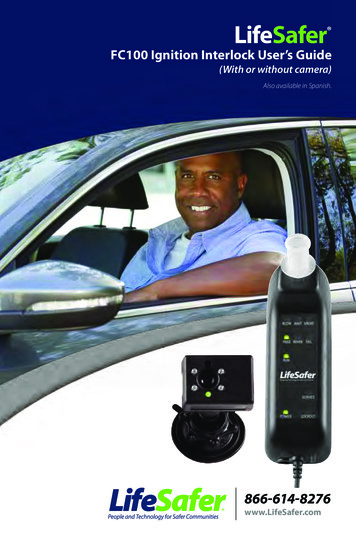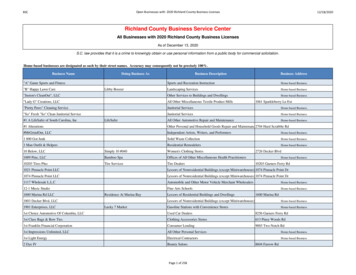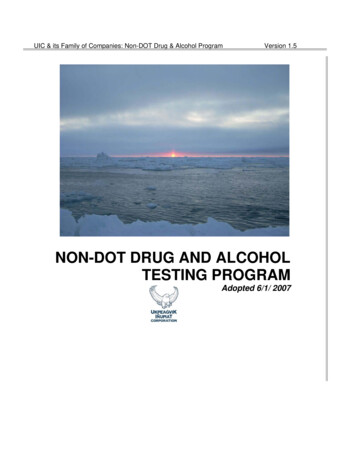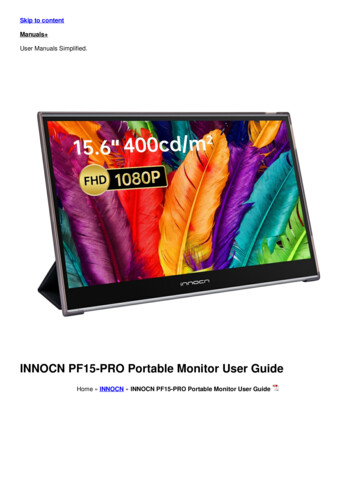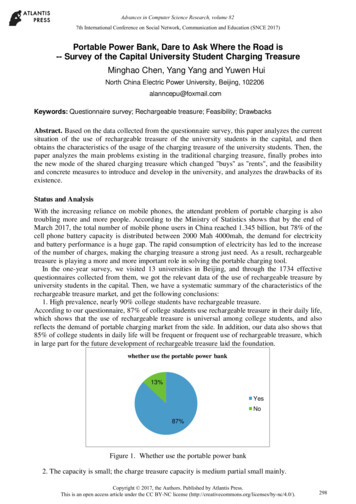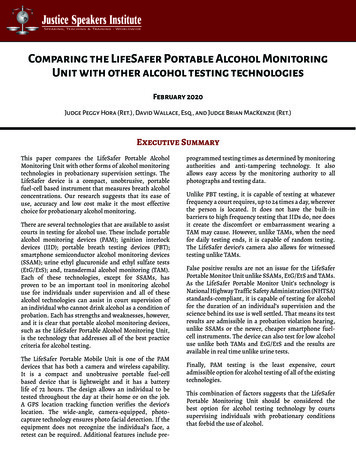
Transcription
Comparing the LifeSafer Portable Alcohol MonitoringUnit with other alcohol testing technologiesFebruary 2020Judge Peggy Hora (Ret.), David Wallace, Esq., and Judge Brian MacKenzie (Ret.)Executive SummaryThis paper compares the LifeSafer Portable AlcoholMonitoring Unit with other forms of alcohol monitoringtechnologies in probationary supervision settings. TheLifeSafer device is a compact, unobtrusive, portablefuel-cell based instrument that measures breath alcoholconcentrations. Our research suggests that its ease ofuse, accuracy and low cost make it the most effectivechoice for probationary alcohol monitoring.There are several technologies that are available to assistcourts in testing for alcohol use. These include portablealcohol monitoring devices (PAM); ignition interlockdevices (IID); portable breath testing devices (PBT);smartphone semiconductor alcohol monitoring devices(SSAM); urine ethyl glucuronide and ethyl sulfate tests(EtG/EtS); and, transdermal alcohol monitoring (TAM).Each of these technologies, except for SSAMs, hasproven to be an important tool in monitoring alcoholuse for individuals under supervision and all of thesealcohol technologies can assist in court supervision ofan individual who cannot drink alcohol as a condition ofprobation. Each has strengths and weaknesses, however,and it is clear that portable alcohol monitoring devices,such as the LifeSafer Portable Alcohol Monitoring Unit,is the technology that addresses all of the best practicecriteria for alcohol testing.The LifeSafer Portable Mobile Unit is one of the PAMdevices that has both a camera and wireless capability.It is a compact and unobtrusive portable fuel-cellbased device that is lightweight and it has a batterylife of 72 hours. The design allows an individual to betested throughout the day at their home or on the job.A GPS location tracking function verifies the device’slocation. The wide-angle, camera-equipped, photocapture technology ensures photo facial detection. If theequipment does not recognize the individual’s face, aretest can be required. Additional features include pre-programmed testing times as determined by monitoringauthorities and anti-tampering technology. It alsoallows easy access by the monitoring authority to allphotographs and testing data.Unlike PBT testing, it is capable of testing at whateverfrequency a court requires, up to 24 times a day, whereverthe person is located. It does not have the built-inbarriers to high frequency testing that IIDs do, nor doesit create the discomfort or embarrassment wearing aTAM may cause. However, unlike TAMs, when the needfor daily testing ends, it is capable of random testing.The LifeSafer device’s camera also allows for witnessedtesting unlike TAMs.False positive results are not an issue for the LifeSaferPortable Monitor Unit unlike SSAMs, EtG/EtS and TAMs.As the LifeSafer Portable Monitor Unit’s technology isNational Highway Traffic Safety Administration (NHTSA)standards-compliant, it is capable of testing for alcoholfor the duration of an individual’s supervision and thescience behind its use is well settled. That means its testresults are admissible in a probation violation hearing,unlike SSAMs or the newer, cheaper smartphone fuelcell instruments. The device can also test for low alcoholuse unlike both TAMs and EtG/EtS and the results areavailable in real time unlike urine tests.Finally, PAM testing is the least expensive, courtadmissible option for alcohol testing of all of the existingtechnologies.This combination of factors suggests that the LifeSaferPortable Monitoring Unit should be considered thebest option for alcohol testing technology by courtssupervising individuals with probationary conditionsthat forbid the use of alcohol.
TI. Introductionhe abuse of alcohol and other drugshas become a long term nationalepidemic.1 The well-establishedconnection between alcohol and otherdrug misuse and crime combined with thecostly failure of incarceration, has createda demand for more effective strategies.2 Inresponse, a national movement supportingcriminal justice reform has increasinglyturned to new sentencing approaches, acomponent of which is the use of technologyto supervise individuals who are subject tocourt orders because of alcohol use.3The best known of these new approachesare Hawaii’s Opportunity Probation withEnforcement (HOPE)4 program whichoriginated in Hawaii; the 24/7 Sobrietyprogram which originated in South Dakota;5and, most widely, the variety of specialtycourts based on the Drug Treatment Courtmodel. Each of these new sentencing andsupervision approaches relies at least, inDrug Treatment Courts’ KeyComponent Number 5 states:“Abstinence is monitored byfrequent alcohol and other drugtesting.”part, on intensive testing for alcohol andother drugs. As Drug Treatment Courts’ KeyComponent Number 5 states: “Abstinenceis monitored by frequent alcohol andother drug testing.”6 This monitoring canprovide an accurate, timely and usefulgage of substance use throughout anindividual‘s court supervision period.7Testing holds probationers accountable andit is an indicator of whether the individual’streatment plan is working.8Page 2There are several technologies that areavailable to assist the criminal justice systemin testing for alcohol use. These include:A. portable alcohol monitoring devices(PAM),9 one of which is the LifeSaferPortable Monitoring Unit;B. ignition interlock devices (IID);C. portable(PBT);breathtestingdevicesD. smartphone semiconductor alcoholmonitoring devices (SSAM);E. transdermal(TAM); and,alcoholmonitoringF. urine ethyl glucuronide (EtG) andethyl sulfate (EtS) tests.10Each of these technologies, except forSSAMs, have proven to be useful inmonitoring alcohol use for individualsunder supervision.According to the American Society forAddiction Medicine’s (ASAM) 2013 WhitePaper, “Breath is the standard matrix11 foralcohol testing because alcohol is volatileand substantially excreted through thelungs.”12 Given the dominance of breathalcohol testing, it is appropriate to start withdevices that use that method before turningto other technologies.II. Testing TechnologiesA. Portable Alcohol MonitoringDevicesPAMs are handheld instruments thatmonitor users’ breath alcohol concentration(BrAC).13 They are commonly used as analternative to remote site breath testingfor probationers who lack a driver’s license
and/or vehicle.14 The majority of thesedevices use the same fuel-cell technologyas IIDs, without the cost of mounting, orinstallation.15Some PAMs are equipped with a cameraand wireless capability.16 These features arecritical components to PAM functionalityand success. A study of breath testing devicesThe LifeSafer Portable MonitorUnit’s technology is NationalHighway Traffic SafetyAdministration (NHTSA)standards-compliant.that were not equipped with a camera foundthat more than 20% were subjected totampering attempts.17 A subsequent studyof devices that had cameras found thattampering attempts were reduced to 1.2%.18The LifeSafer Portable Mobile Unit is oneof the PAM devices that has both a cameraand real time reporting capability. It is acompact and unobtrusive portable fuel-cellbased device that is lightweight and has abattery life of 72 hours.19 The design allowsindividuals to be tested throughout the day athome or on the job.20 A GPS location trackingfunction verifies the device’s location.21The wide-angle, camera-equipped, photocapture technology developed for LifeSaferinterlocks ensures facial detection thatrequires a retest if it does not identify theindividual.22Additional features include up to 24daily, pre-programmed testing times asdetermined by monitoring authorities,along with anti-tampering technology.23It also is capable of real-time reporting oftesting data.24If a test registers a BrAC level required bythe court, the LifeSafer device will requirea retest.25 The default setting for the unitinitiates a retest request five minutes afterthe failure to ensure any ning breath spray or mouthwash)to dissipate. This reduces the chances offalse positives. Testing ends after a secondretest with a pass, a skip,26 or fail beingreported.27 Courts can request customizedtesting protocols which are designed tofit their probtaionary requirements.28The LifeSafer Portable Monitor Unit’stechnology is National Highway TrafficSafety Administration (NHTSA) standardscompliant29 and it is capable of testing foralcohol for the duration of an individual’ssupervision.The LifeSafer device reports data after eachtest.30 All relevant information is uploaded,including test results, photographs, andGPS data via a cellular connection.31 Datais stored in secured servers.32 In the eventof a skip or failure, the device provides animmediate real time violation notification bytext or email to the supervising authority.33PAM devices that use fuel-cell technologyhave results that are sufficiently reliableto be admissible in probation violationproceedings.34B. Ignition Interlocks DevicesAn IID is a breath-testing device attached toa vehicle’s ignition system that requires anindividual to provide a breath sample freefrom alcohol before the vehicle will start.35Most states now require fuel cell interlocks.36In some models, breath alcohol test resultsare downloaded when an individual reportsto an installer to have the IID calibrated.37Page 3
All positive samples are recorded andthe results are sent to the supervisingauthority.38 Recently, some companies, likeLifeSafer, have added real time reportingtechnology to IIDs.39 These devices nowhave the capacity to report positive alcoholtests in real time instead of waiting until thevehicle is brought in for calibration.40officers. They must be calibrated monthlyby a certified technician to ensure accuratereadings45 and they generally have an LCDscreen where the BrAC is displayed. Thereis a disposable mouthpiece which mustbe changed after each test.46 Most of thesedevices have no printout capability.47Most courts that order IIDs do so to preventindividuals from driving after they haveconsumed alcohol. Some also use thesedevices for daily or random breath testingwhen abstinence is a condition of probationor release from custody. IID test resultshave been held to be admissible in probationviolation proceedings.41PAM devices without a camerahave high rates of tamperingattempts.Devices without a camera have high rates oftampering attempts. In one study 21% of thedevices without cameras had been subjectedto a subversion attempt.42 The driverswho tampered with their IIDs averaged11.6 attempts to start their vehicle.43 Asubsequent study however, established thatwhen IIDs are equipped with a camera, theattempted tampering rate was reduced to1.2%.44The biggest limitation for the use of IIDs fordaily alcohol testing relates to its primarypurpose of preventing the operation ofa vehicle if the individual has consumedalcohol. Not all program participants owna vehicle. Using an IID for daily testingrequires that probationers go to the vehicleand start it before they can take a breathtest. This may create a barrier to the numberof times an individual can be tested, as theymay not have immediate access to a vehicle.C. Preliminary Breath TestingPBT devices are easy to use and portable.While handheld, they are typically usedby law enforcement officers or probationPage 4Some court officials, law enforcementagencies and private drug testing companiesuse PBTs48 and many of these devices areNHTSA-standard compliant.49 In suchsettings they are cost effective, provideobserved tests and are generally admissiblein probation violation hearings to determinethe presence of alcohol.50There are limitations on PBT devices, suchas the requirement that an individual travelto a testing site or police station, which cancreates difficulties for many participants asthey often do not have drivers’ licenses ora vehicle. This remote testing requirementalso limits the number of times that anindividual can be tested during the day andlimits night and weekend testing. If thecourt staff is doing the testing, there is theadditional cost of the staff time.D. Smartphone SemiconductorAlcohol Monitoring DevicesSSAMs combine the use of a participant’ssmartphone with a semiconductor breathtesting device. The semiconductor uses acoating of tin dioxide connected to a smallmetal heater.51 The heater warms the coatingso the device can detect the presence ofalcohol.52
The breath-testing device wirelesslytransmits the results to an application on theindividual’s smartphone.53 That applicationis programed to transmit the data to thetesting company.54accurate.63 Given this lack of scientific andtechnological supporting evidence, thereare no published cases that support theadmission of SSAMs into evidence in aprobation violation hearing.SSAMshaveseverelimitations.Semiconductor technology is widelyrecognized to be less accurate then fuel-celltechnology.55 If the heater fails, the devicecan give a false reading.56 However, evenwhen properly heated, the semiconductorreacts to more than the presence of alcoholincluding such substances as cigarettesmoke, perfume, hairspray and breathfresheners.57 This can cause a false positivereading and an unsupported accusation ofalcohol use.58As the problems with semiconductortechnology have been exposed, severalsmartphone alcohol monitoring companieshave begun using low cost fuel-cell devices.In addition, SSAMs show wide variations intest readings, especially as the units becomeolder or extensively used.59 They also requirecalibration service on a more frequentbasis than PAMs and IIDs with fuel celltechnology, in some cases once a month.60SSAMs also have difficulties takingconsecutive samples in a short period oftime.61 The level of tin dioxide decreases withGiven the lack of scientific studies,there is a serious question as towhether these new cheap fuel celldevices (SSAMs) can meet currentcourt admissibility standards.each test, so the device needs to be restedto allow atmospheric oxygen to oxidize thesemiconductor again.62A study of SSAMs found they exhibitedan error rate of at least 25% concludingthat none of the devices were sufficientlyIn one instance, a company using the newlow cost fuel-cells claimed that it was a “lawenforcement grade product, utilizing a nextgeneration electrochemical fuel-cell sensorthat has undergone rigorous governmentlab-grade testing to ensure its accuracy.”64The Federal Communications Commissionsued the company for false advertisingclaiming that the company was aware thatambient humidity and temperature affectedresults and that its sensors deterioratedsignificantly over time.65 The companyresolved the lawsuit66 and the settlementterms included barring the company frommaking future claims of accuracy for itsproduct unless rigorous testing supportedsuch claims.67 The company was alsorequired to contact and pay full refunds toall of consumers who bought the device.68As of this writing there are many corporateclaims regarding these devices but alack of scientific evidence about theireffectiveness.69 Given the lack of scientificstudies, there is a serious question as towhether these new, cheap fuel-cell devicescan meet court admissibility standards.70E. Transdermal Alcohol MonitorsUnlike breath testing devices, TAMs do nottest for BrAC levels; instead they detectalcohol that secrets through the pores ofthe skin.71 This is known as transdermalalcohol concentration (TAC). Given thePage 5
body’s absorption process, TACs suffer aninherent lag behind BrAC in testing for peakblood alcohol of approximately two hours.72The delay is created by measuring the timeit takes for ethanol to go from a liquid stateto a gaseous state once ingested by the bodyand then to be expelled as sweat.73Researchers have concluded that lowconsumption of alcohol (less than two drinks)is less likely to be detected by TAMs.74 In onestudy 39% of participants who consumedone beer had no positive TAC readings.75 Ina second study, 38% of participants did notregister a positive TAC reading after onedrink.76 In a third study, researchers foundthat 188 of 690 (27%) drinking episodes werenot detected by TAMs.77 These results haveled one researcher to state:“. [R]egardless of how reliable andaccurate transdermal alcohol devicehardware becomes at measuring TAC,the raw TAC data will never consistentlymap directly onto BrAC/BAC acrossindividuals and drinking episodes.”78TAMs’ difficulty detecting low level drinkingappears to be related to the effort to avoidfalse positives.79 A report sponsored byNHTSA determined that a TAM set totest at 0.02 g/dL TAC provided optimaldiscrimination for low level drinking, butthat this sensitivity level resulted in a 12.34%false-positive test rate.80 A subsequent studysuggested that changing the sensitivitylevel could reduce this false positive rate.81However, the report noted that raising thecut off level decreased the likelihood of theTAM detecting low level drinking.82At least one study suggests that except incircumstances of binge drinking, TAMs arealso less likely to detect alcohol use in menthan women.83 A different study suggeststhat the explanation for this variance is thePage 6difference in the makeup of the outer skinof women and men; however, as the authorsstate, there has not been enough research toexplain why this occurs.84Several reports have discussed discomfortcaused by wearing the TAM bracelets.85Participants have reported moderatephysical discomfort with 61.5% ofparticipants reporting marks on their skin.86This irritation appears to be related to thephysical shape and size of the bracelet.87Some studies have also reported that TAMscreate a sense of stigma and embarrassmentwhich can be a concern for those wearingthem.88Generally, TAM test results are stored forupload to computers for reporting andanalysis and sent to the supervising authoritydaily.89 Any attempt to remove or tamperwith the TAM device is communicated to thevendor when the TAC data are uploaded.90Attempting to prevent a data upload wouldalso be reported.91 Some TAMs now includeGPS functionality and can transmit the datawirelessly.92Courts have held that transdermaltechnology is sufficiently reliable for theresults to be admitted in probation violationhearings.93F. Urine Ethyl Glucuronide and EthylSulfate TestsEtG and EtS are direct, non-volatile, watersoluble, metabolites of ethanol (drinkingalcohol) which can be detected in a urinetest.94 An EtG/EtS urine panel can be the soleelement of a urine test or be used as part ofa larger number of urine panels testing forother drugs.95There is a general consensus that criminaljustice EtG testing should have a 500 ng/
mL cutoff setting to reduce the possibilityof false positives.96 This cutoff level allowsan EtG test to identify the presence of ethylglucuronide in high levels of drinking fora period of up to 72 hours after alcoholconsumption.97 However, while it can detectlow levels of alcohol consumption (one to twodrinks) for an interval of 12 hours to 24 hoursafter drinking, after that time the test hasdifficulty detecting alcohol consumption.98After 48 hours, the test is unable to detectany consumption of less than six drinks.99Reducing cutoff levels can improvedetection. In one study, more than 80% ofThere is a general consensus thatcriminal justice EtG testing shouldhave a 500 ng/mL cutoff to reducethe possibility of false positives.those who drank alcohol 24 hours prior totesting were identified using the 100 and200 ng/mL cutoffs.100 After 24 hours thedetection rate fell below 40% for those with100 and 200 ng/mL cutoffs while the 500ng/mL level fell below 25%.101 After 48 hourstests taken at 100 and 200 ng/mL cutoffsdetected alcohol use only 21% of the time,while the 500 ng/mL level fell below 10%.102This rapidly diminishing effectiveness ledthe author of one leading study to conclude“commercially available EtG testing must beconducted every 24 hours .”103While reducing the EtG sensitivity level to200 ng/mL improves detection, the reasonthat the 500 ng/mL cutoff is the suggestedstandard for criminal justice testinginvolves the issue of false positives.104According to the ASAM’s White Paper onDrug Testing, “the EtG immunoassay testis prone to analytical false positives.”105 Thewhite paper points out that many productsincluding mouthwash, cough syrup, andhand sanitizers can produce positive EtGtests.104 Setting a 500 ng/mL cutoff for EtGtests reduces, but does not eliminate, thesefalse positive tests.107For EtS the suggested standard for criminaljustice testing is 100 ng/mL.108 At that cutofflevel the problems with alcohol detection inthe short and long term are similar to thosedescribed for EtG tests.109Given the possibly of false positives, absentan admission of drinking by the probationer,all positive EtG/EtS test results must be sentfor a GC-MS or LC-MS/MS110 confirmationtest.111Beyond the long term detection and falsepositive issues, the primary problem withurine testing is that the urine specimencan be tampered with.112 These attemptscan include such things as water loading,substituting negative specimens for theirown sample, or using a cleaning product.113The risk of alteration can be lessened whenstaff observes all sample collections duringtesting.114 Of course the increased staff timecan add to the overall cost of the test.III. Comparison ofTechnologies Using BestPracticesThe most objective manner for analyzingthese alcohol detection technologies requiresthe application of best practice criteria forcourt ordered testing. The foremost existingstandards were created for drug treatmentcourts.115 These standards combine scientificresearch and case law to create sustainableproven procedures that can be replicatedfrom one court to another.116 Although thereis nothing that requires a court to adoptPage 7
these best practices, they have been shownto produce the most reliable results.117resistance by requiring an individual to goto their car for multiple daily tests.Best practices in the area of alcohol testingencompasses the following:118TAMs, which test for TAC every 30 minutes,are designed to test frequently.A. Frequent testingB. Random testingC. Duration of testingD. Witnessed collectionE. Valid specimens/accurate resultsF. Rapid resultsApplying these best practices to the differentalcohol testing technologies allows for anobjective comparison approach.A. Frequent TestingFor individuals suffering from an alcoholuse disorder, multiple daily tests havebeen shown to be effective.119 Each ofthe technologies listed are capable ofseveral alcohol tests daily. However, forremote site PBT testing it can be difficultfor individuals to report for testing formultiple reasons, including transportationdifficulties, staffing requirements, and timecommitments.The LifeSafer unit can be programed totest up to 24 times in a day.120 Currentresearch suggests that testing that manytimes is excessive, as PAMs generally candetect alcohol use for three to five hours.Thus, there appears to be a consensus thattesting four times per day is adequate formonitoring purposes.121IIDs like PAMs can be used for multiple dailytests, with the caveat that there is a certainlevel of inconvenience that may createPage 8Best practices for random testingalso require the shortest possibletime between the notificationand the test.SSAMs may be programed to test multipletimes a day, but the semiconductortechnology has difficulty taking consecutivesamples in a short period of time.122 Thesensor needs to be rested to allow it tooxidize prior to the next test.123Finally, to accurately detect low-level alcoholuse, EtG/EtS tests should be conductedevery 12 to 24 hours.B. Random TestingAs a participant in a treatment court or in anintensive probationary setting progressesin the program, the number of alcohol andother drug tests should decline.124 Whennot testing daily, existing research provesthat random testing is more effective thanroutine testing.125Except for TAMs, each of the listedtechnologies are capable of random alcoholtests.Best practices for random testing alsorequire the shortest possible time betweenthe notification and the test.126 The LifeSaferdevice, certain IIDs and SSAMs can sendimmediate test notifications wirelessly.127Both remote site PBTs and EtG/EtS mustprovide time for the individual to travel tothe locale of the testing.
C. Duration of TestingAll these technologies are capable ofmeeting the long-term probationary testingrequirements set by a court.Except for EtG/EtS, each of the technologiesrequire regular service recalibration. Allbreath testing devices must be reset in orderto ensure that an accurate BrAC result.The same is true of TAM devices. SSAMshowever, have a shorter lifespan that mayrequire an increased number of calibrationsor replacing the device on longer-termprobationary periods.D. Witnessed CollectionIndividuals attempt to cheat alcohol andother drug tests.128 Therefore some form ofobservation of the test is critical.As the technology that is most vulnerable totampering, EtG/EtS requires observationwhile an individual is giving a urinespecimen. This means the agency must haveboth male and female collectors.133E. Valid Sample/Accurate ResultsObtaining a valid sample is necessary toobtain a reliable test.134 With EtG/EtS, oncethe procedures to avoid tampering havebeen established and followed, the onlyother requirement is an adequate amountof urine.TAMs take a sample of the ethanol vaporexuding from the skin every 30 minutes.135However the delay in the testing periodbetween peak BrAC and when the TAC peaksRemote site PBT tests are observed andmeet this best practice. IIDs and PAMswith cameras, like the LifeSafer unit, offera technological form of observation. Thesecameras have been shown to be effective inpreventing tampering.129As the technology that is mostvulnerable to tampering, EtG/EtS requires observation whilean individual is giving a urinespecimen.Some SSAMs use the smartphone’s camerain an attempt to capture the image ofthe person taking the test. However, theindividual’s ability to hold the phone andthe direction of the camera limits theireffectiveness.is significantly affected by the amount ofalcohol ingested.136 TAMS have difficultydetecting low alcohol use and if sensitivitylevels are set too low they can experience ahigh percentages of false positives.Since TAMs are attached to the person,the tests are not “witnessed.” As a result,they have been the subject of numeroustampering attempts.130 One set of casestudies in 2012 found over 16% of thosewearing a TAM had a tampering incident.131In a report issued a year later, by the VirginiaDepartment of Criminal Justice, the numberof tampering attempts was almost 24%.132PAMs, IIDs, PBTs and SSAMs all take breathsamples. Each requires an individual toblow into the device to obtain the sample.After alcohol is ingested, it goes into thestomach and small intestine to be absorbedin the blood.137 The liver breaks down mostof the alcohol that has been consumed.138Nearly all of the remaining alcohol in theblood is eliminated first through urineand then breath.139 A sample is taken frombreath and any alcohol present is as a resultPage 9
of alcohol evaporating from the blood intothe lungs.140 When the level of ethanol inthe breath is constant, the sample shouldbe taken.141 The accuracy of the test dependson obtaining alveolar (deep lung) air142 andthe device used. Breath requires a certainvolume to obtain a good sample and not allthese technologies are equal.In order to obtain an accurate sample eitherthe device or a person must ensure that asample of deep lung breath is taken. PBTsare monitored by a person who controls thelength of the breath and are very accurate.143Devices that meet NHTSA standards, likecertain IIDs and the LifeSafer PortableMonitoring Unit’s technology, ensure thatthe volume of breath is sufficient to obtain avalid breath sample.144The LifeSafer Portable Monitoring Unit hasa light and tone system to ensure that asufficient volume of breath is taken.145 Whenan appropriate breath sample has beenprovided, the device notifies the individualwith a tone and light to indicate they maystop blowing.146 If the volume is insufficient,the handset will sound a high-pitched triplebeep and the red abort light will come on.147As far as may be determined, SSAMs donot have technology to ensure the volumeof breath is sufficient to obtain an alveolarbreath sample. Some of these devices havetimers that require an individual to blowinto the device for up to five seconds.148Others have timers that are set by the user.149Some SSAMs requires the individual towhistle or hum as they blow into the device.In one instance, a user was able to “ get a0.0 reading simply by whistling rather thanblowing into the mouthpiece while the testwas underway.”150SSAMs, along with EtG/EtS and TAMs,can produce false positive readings. EtG/Page 10EtS tests are subject to independentconfirmation tests; the other two are not.Thus, the problem posed by false positives isgreater for SSAMs and TAMs.F. Rapid ResultsTest results, including confirmation, whichare conveyed to criminal justice staff within48 hours of sample collection are 73% moreeffective in reducing crime than whenresults take longer.151 Moreover, the soonersanctions are imposed after a missed orpositive test, the better the outcomes.152Equally, the faster positive rewards aregiven for negative tests, the more impactfulon an individual’s behavior.153 The LifeSaferPortable Monitoring Unit and IIDs havesimilar abilities to upload the results to courtstaff in real time.154 That means they areaware of violations almost as they happen.SSAMs also generally report in real time.Some older versions of IIDs, PAMs andTAMs upload test information only whenthe device is calibrated. That means reportsDevices that meet NHTSAstandards, like certain IIDs andthe LifeSafer Portable Moni
This paper compares the LifeSafer Portable Alcohol Monitoring Unit with other forms of alcohol monitoring technologies in probationary supervision settings. The LifeSafer device is a compact, unobtrusive, portable fuel-cell based instrument that measures breath alcohol concentrations. Our research suggests that its ease of


